Learn to cultivate Hass Avocado, celebrated for its creamy taste and health benefits. This straightforward guide covers the basics, helping you start your own Hass avocado garden. The Hass avocado, known for its creamy texture and rich flavor, has gained immense popularity worldwide. If you’re looking to grow your own Hass avocados, this guide will provide you with the essential steps and tips to get you started.
| Benefit | Description |
|---|---|
| Nutritional Value | High in essential nutrients like potassium, vitamin E, B-vitamins, and folic acid. |
| Healthy Fats | Rich in monounsaturated fats which are heart-healthy and help reduce bad cholesterol levels. |
| Fiber Content | Contains both soluble and insoluble fiber which aids in digestion and helps maintain a healthy gut. |
| Antioxidants | Abundant in antioxidants such as lutein and zeaxanthin, which are beneficial for eye health. |
| Weight Management | The fiber and healthy fat content can help you feel full longer, aiding in weight management. |
| Skin Health | The vitamins and healthy fats in avocados can contribute to healthy, glowing skin. |
| Versatility in Cooking | Can be used in a variety of dishes, from guacamole to smoothies, adding both flavor and nutrition. |
| Absorption of Other Nutrients | The fats in avocado can enhance the absorption of fat-soluble vitamins (A, D, E, K) from other foods. |
Choosing the Right Location
Climate Considerations
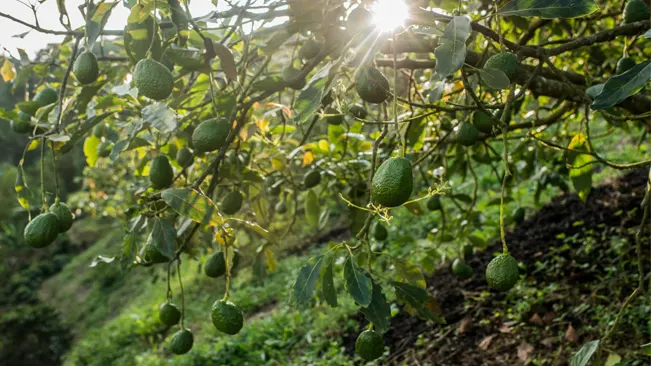
Warmth and Sunlight
- Hass avocado trees flourish best in warm climates found in USDA zones 9 to 11.
- They need a lot of sunlight, at least 6 hours of direct sun daily, for healthy growth and fruit production.
- Being sensitive to cold, they struggle in temperatures below 32°F (0°C). Frost can severely damage or kill the tree.
Frost Protection
- In areas with occasional frost, planting the tree near a building or a wall can offer some warmth and protection.
- Using frost cloths or blankets to cover the tree on cold nights can also help.
- For those in cooler regions, consider container planting. Growing Hass avocados in pots allows you to move them indoors or to a more protected area during colder months.
Soil and Space
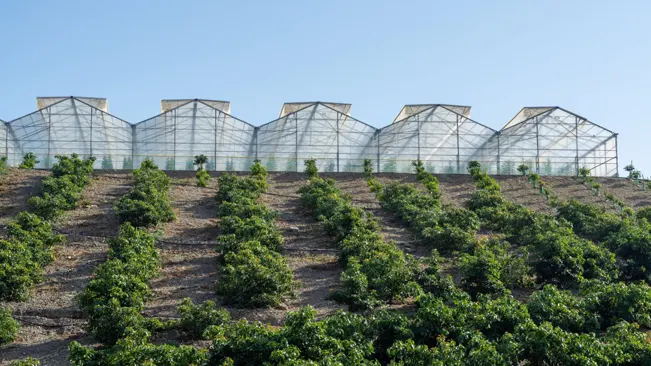
Soil Quality
- Well-draining soil is crucial. Hass avocado trees are particularly susceptible to root rot when in waterlogged soil.
- They prefer slightly acidic to neutral soil (pH 6 to 7). It’s a good idea to test your soil’s pH and adjust it if needed.
- If your soil doesn’t drain well, consider amending it with organic matter or building a raised bed to improve drainage.
Space Requirements
- Hass avocado trees can grow up to 30 feet tall and equally wide in the right conditions, so they need ample space.
- When planting multiple trees, keep them at least 15 to 20 feet apart to ensure enough room for growth.
- If space is limited, choose a dwarf variety or prune regularly to manage the size of the tree.
Sunlight and Air Flow
- Along with sunlight, good air circulation is important. Avoid overly sheltered spots where air becomes stagnant, as this can encourage fungal diseases.
How to Grow Hass Avocado Tree
Growing from Seed
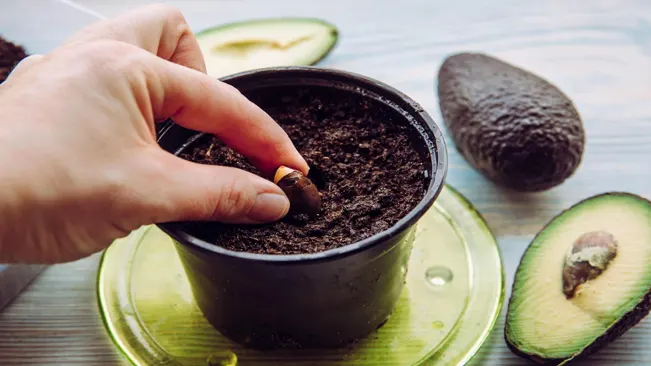
- Timeframe: Growing a Hass avocado tree from a seed can be an interesting project, but it typically takes anywhere from 5 to 13 years to bear fruit. In some cases, it might not bear fruit at all.
- Variability: The fruit from a seed-grown tree might not resemble the Hass avocados you’re accustomed to, as the tree will be a hybrid of two different avocado varieties.
- Process: To grow from a seed, you’d need to start with a fresh pit, clean it, and use toothpicks to suspend it over water in a glass. Once it sprouts and grows a stem and roots, it can be planted in soil.
Using a Grafted Sapling
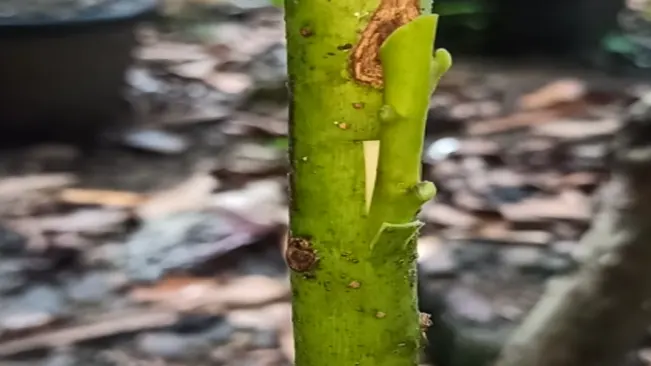
- Predictability: A grafted sapling is more reliable for producing true Hass avocados. The grafting process involves joining a piece of a mature, fruit-bearing Hass avocado tree (the scion) to a hardy rootstock.
- Time to Fruit: A grafted sapling can start producing fruit in as little as 3 to 4 years.
- Availability: You can find grafted Hass avocado saplings at reputable nurseries or garden centers.
Planting Process
Selecting the Right Location
- Choose a sunny spot in your garden that receives at least 6 hours of sunlight per day.
- Ensure the area has good air circulation and is not prone to frost pockets.
Preparing to Plant
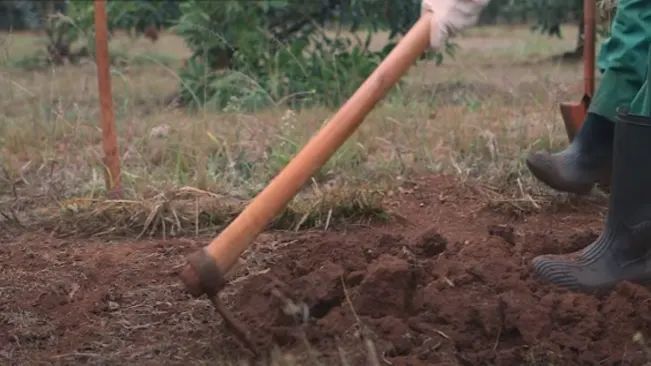
- Soil: Avocado trees prefer a pH of around 6 to 6.5. If your soil is too acidic or alkaline, you may need to amend it.
- Drainage: Good drainage is crucial. Consider building a raised bed or mound if your soil retains moisture.
Planting Steps

- Hole Preparation: Dig a hole that is as deep as the root ball of your sapling, but at least twice as wide. This loosens the soil and gives roots room to spread.
- Root Handling: Carefully remove the sapling from its container. Inspect the roots and gently untangle any that are bound.
- Planting: Place the tree in the center of the hole. The top of the root ball should be level with the soil surface.
- Backfilling: Fill the hole with soil, gently patting around the base to remove air pockets.
- Watering: Water the tree thoroughly after planting. This settles the soil around the roots and provides necessary hydration.
- Mulching: Apply a layer of mulch around the base of the tree to retain moisture and suppress weeds. Keep the mulch a few inches away from the trunk.
Caring for Your Hass Avocado Tree
Watering Hass Avocado Trees

- Deep Watering: It’s important to water avocado trees deeply. This means the water should reach deep into the soil to encourage the roots to grow downward, establishing a stronger foundation.
- Frequency: The watering frequency depends on the age of the tree and the climate. Young trees need more frequent watering as they establish themselves. As trees mature, they can tolerate less frequent watering.
- Monitoring Moisture Levels: Over-watering can be detrimental, leading to root rot. Check the soil moisture by digging a few inches into the soil. If it feels dry at that depth, it’s time to water.
- Seasonal Adjustments: Reduce watering in the cooler months when the tree’s growth slows down and increase it during the warmer, growing season.
Fertilizing Hass Avocado Trees
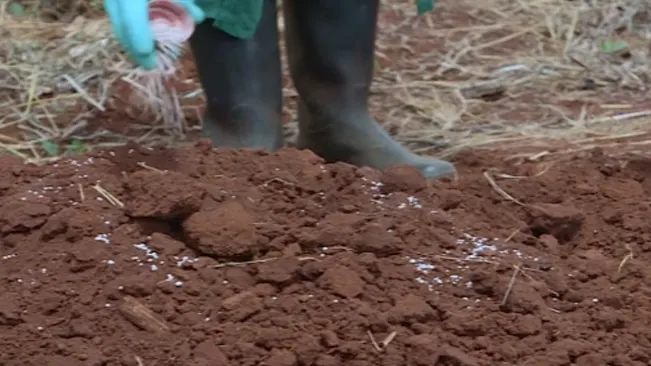
- Balanced Fertilizer: Choose a fertilizer that has an equal balance of nitrogen, phosphorous, and potassium (often labeled as N-P-K).
- Adding Zinc: Ensure the fertilizer includes zinc or supplement with a zinc source, as avocados have high zinc requirements.
- Application Timing: Fertilize in the early spring as new growth starts and again in the summer. Avoid fertilizing late in the season as this can promote new growth that’s susceptible to frost damage.
- Young Trees: For newly planted trees, it’s often recommended to wait a year before applying fertilizer to avoid burning the roots.
Pruning Hass Avocado Trees
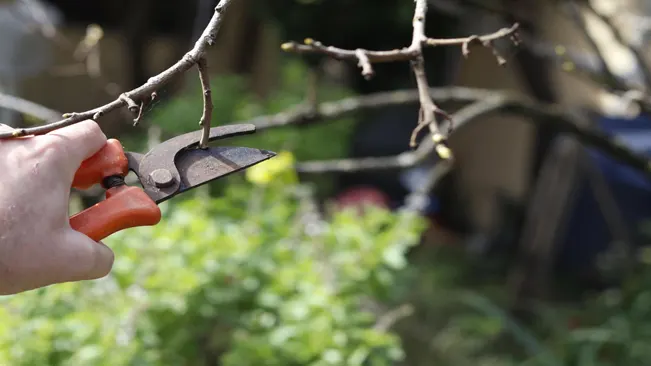
- Timing: The best time to prune is in early spring. Avoid heavy pruning in late summer or fall, as this can stimulate new growth that may not harden off before winter.
- Objective: The goals of pruning are to maintain the tree’s shape, manage its size (especially if it’s in a confined space), and remove any dead or diseased wood.
- Technique: Use clean, sharp pruning tools. Make cuts at a 45-degree angle and avoid leaving stubs as these can become entry points for pests and diseases.
- Light Pruning: It’s better to prune lightly and regularly rather than heavily at once, as over-pruning can stress the tree and reduce fruit production.
Pest and Disease Management

Pest Management
- Avocado Lace Bugs: These small, delicate insects feed on the underside of leaves, causing yellow blotches and leaf drop. They are more prevalent in dry conditions. Control measures include using insecticidal soaps or oils and ensuring good irrigation practices.
- Mites: Including persea mite and six-spotted mite, they cause yellow spots or bronzing on leaves. Miticides can be effective, but often natural predators like ladybugs can keep their population in check.
- Caterpillars: They can cause significant damage by feeding on leaves and tender shoots. Handpicking or using biological controls like Bacillus thuringiensis (Bt) can be effective in managing these pests.
Disease Prevention
- Root Rot (Phytophthora cinnamomi): The most common and serious disease in avocado trees. It’s caused by a soil-borne fungus and is exacerbated by over-watering and poor drainage. Symptoms include wilting, leaf drop, and branch dieback. Preventive measures include planting in well-draining soil, avoiding over-watering, and using fungicides if necessary.
- Anthracnose: This fungal disease affects fruits, causing black spots that expand as the fruit ripens. Good orchard hygiene, like removing fallen leaves and fruit, and applying fungicides, can help control this disease.
- Canker Diseases: Caused by various fungi, these create lesions on branches and stems. Prune away affected areas and ensure good air circulation around the tree.
Integrated Pest Management (IPM)
- Regular Monitoring: Regularly inspect your trees for signs of pests or diseases.
- Cultural Practices: Maintain healthy trees through proper watering, fertilizing, and pruning. A healthy tree is less susceptible to pests and diseases.
- Biological Control: Encourage natural predators and beneficial insects.
- Chemical Controls: Use them as a last resort, and prefer organic or less harmful options where possible.
Harvesting Your Avocados
Timing the Harvest
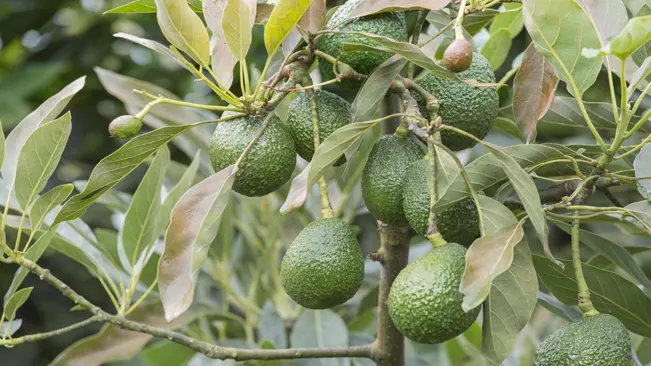
- Maturity Indicator: Hass avocados don’t change color or soften while on the tree, unlike many other fruits. Instead, they mature on the tree but ripen off it. The maturity of Hass avocados is generally determined by their size and the time of year. They typically need about 7-8 months from flowering to reach maturity.
- Seasonal Considerations: In most growing regions, the harvesting season for Hass avocados starts in late winter and continues into early summer. However, this can vary depending on your local climate and conditions.
Identifying a Ripe Avocado
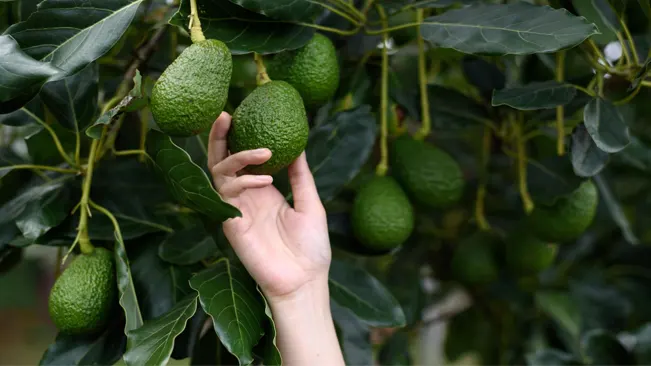
- Skin Texture and Color: As Hass avocados mature, their skin changes from green to a dark, almost black color, and the skin becomes more pebbly.
- Feel: Gently squeeze the avocado without applying too much pressure. A mature avocado will be firm but will yield slightly under pressure. If it’s hard, it needs more time on the tree; if too soft, it may be overripe.
Harvesting Technique
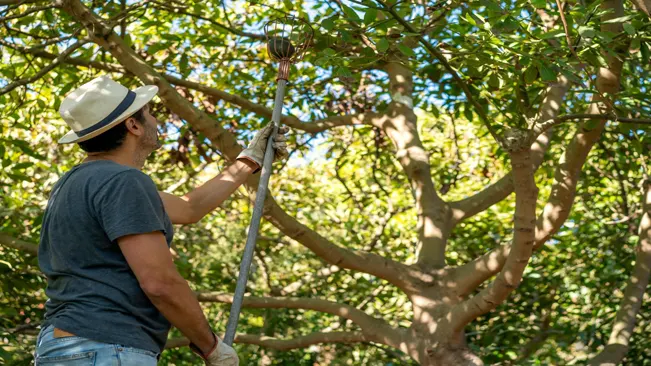
- Cutting from the Tree: Use pruning shears or a pole harvester to cut the avocado stem close to the fruit. Avoid pulling or twisting avocados off, as this can damage the tree and the fruit.
- Handling Carefully: Handle the avocados gently to prevent bruising. Even small blemishes can lead to faster decay once the fruit begins to ripen.
Post-Harvest Ripening

- Ripening Process: After harvesting, Hass avocados usually take about one to two weeks to ripen at room temperature. They’re ready to eat when they feel slightly soft to the touch.
- Speeding Up Ripening: To speed up the ripening process, you can place the avocados in a brown paper bag with an apple or banana. The ethylene gas produced by these fruits accelerates ripening.
Storage
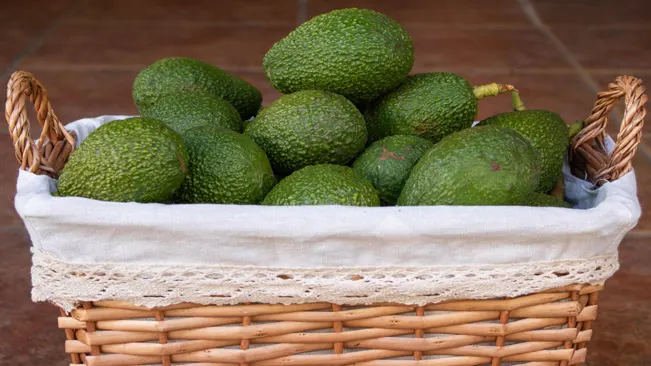
- Before Ripening: If you’re not ready to use the avocados, keep them at room temperature in a cool, dark place.
- After Ripening: Once ripe, avocados can be stored in the refrigerator for several days to slow down further ripening.
Significance of Proper Harvesting
- Harvesting Hass avocados at the right time is crucial for several reasons. Picking them too early can lead to flavorless and rubbery fruit, while late harvesting can reduce the fruit’s shelf life and increase the risk of diseases. Proper harvesting ensures that the avocados develop their characteristic creamy texture and rich flavor.
Conclusion
Growing Hass avocados provides not only a lush, attractive addition to your garden but also promises a generous yield of delicious fruits. By providing the appropriate care and ideal growing conditions, you can savor the unique flavor of home-grown avocados for many years. This rewarding endeavor is a perfect blend of horticultural beauty and practical, nutritional benefits.
FAQs (Frequently Asked Questions)
- What climate is best for growing Hass avocados?
Hass avocados thrive in warm, temperate climates, usually in USDA zones 9 to 11. They need plenty of sunlight and are sensitive to frost. - Can I grow a Hass avocado tree from a seed?
Yes, but it may take several years to bear fruit, and the fruit’s quality may not be consistent with the parent tree. Using a grafted sapling from a nursery is more reliable. - How much space does a Hass avocado tree need?
These trees can grow up to 30 feet tall and wide, so they need ample space. Consider the mature size of the tree when choosing a planting location. - How often should I water my Hass avocado tree?
Water deeply but infrequently, allowing the soil to dry out slightly between watering sessions. Over-watering can lead to root rot. - What type of soil is ideal for Hass avocados?
Well-draining soil is crucial. Avocado trees do not tolerate wet feet, so ensure good drainage to prevent root rot. - Do Hass avocado trees require a lot of sunlight?
Yes, they need full sun for optimal growth and fruit production. A minimum of 6 hours of direct sunlight daily is recommended. - When is the best time to plant a Hass avocado tree?
Spring is typically the best time, as it gives the tree time to establish roots before the colder months. - How do I fertilize my Hass avocado tree?
- Use a balanced fertilizer that contains nitrogen, phosphorous, potassium, and crucially, zinc. Fertilize during the growing season following the product’s instructions.
- Do Hass avocado trees need pruning?
Light pruning is beneficial for shaping the tree and removing dead or diseased wood. However, excessive pruning can reduce fruit production. - When are Hass avocados ready to harvest?
Harvest when they reach a mature size and are slightly firm. They ripen after picking, usually within one to two weeks.
Credit: Source link